ATH-MSR7
back to Audio Technica
back to measurements
home
published: Oct-11-2019
NO SMOOTHING is applied to the shown plots. Most measurement sites have some smoothing applied which ‘irons flat’ sharp peaks and ‘wiggles’. I do not use smoothing because some info about sound quality is lost when plots are smoothed.
Aside from a small correction of the microphone itself also some correction in the lowest frequencies is applied to the plots to compensate for the perceived loss of bass when using headphones. This is described HERE in more detail.
A ‘horizontal‘ frequency response curve on the shown frequency response plots on this website thus indicates a perceived ‘flat’ tonal signature.
ALL measurements are made with a good SEAL on a flatbed measurement rig.
The shape of your head, bone structure, pad size, pad ‘softness, (compliance), hair or no hair and or wearing glasses may (drastically) change the frequency response of some headphones, so… your personal experience may differ substantially from these plots.
Frequency response (tonal balance) is the most sound-determining aspect of headphones. A horizontal line shows audible neutral response in the plots on this website. Deviations in different severities at different frequency bands have an effect on the sound character.
The bigger the deviation the stronger the effect.
Below an aid to help determining the sound character of headphones with relation to the frequency response.

audio-technica ATH-MSR7
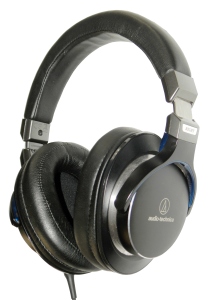
The audio-technica ATH-MSR7 is a closed headphone launched in 2014 and discontinued (or should I say replaced) in 2018 by a balanced version, but can still be found new here and there. It sold for around € 250.-.
It can be found in the ‘headband’ section on the audio-technica website. It is not listed in the ‘Hi-Fi’ nor the ‘studio’ section .
It has been replaced by the ATH-MSR7b. These can easily be told apart as the b-version has blue (or red) instead of aluminium colored accents on the cups and are dual entry.
The b-version is not just a balanced ATH-MSR7 but is said to be improved acoustically as well, has improved pads and can be used with ‘normal’ and balanced music sources.
The non-b version can only be used with 3-pin TRS jack devices and is single-entry (left side).
Just like with the ATH-M50X one needs to be very careful not to buy a fake (see picture below).
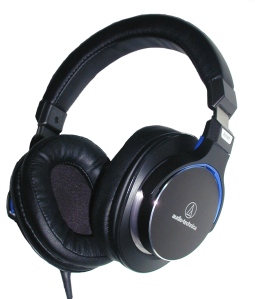 It was available (just like the ATH-MSR7b still is) in 2 different color schemes.
It was available (just like the ATH-MSR7b still is) in 2 different color schemes.
Black with blue and Gunmetal with brown and red accents.
The measured headphones is second hand and has quite a few hours on it.
This is only visible in the pads. The pads on the right side started to flake. The ones on the left side are beginning to show signs of wear. Fortunately these can be replaced.
The first set of measurements showed substantial differences between left and right channel. Some of the measurements were re-done with the pads swapped. This would be closer to the performance when new.
The pads are made of pleather, which is cloth covered with a thin layer of PVC with leather look. These pads are cheap, look good and are comfortable when new. The disadvantage is that these pads deteriorate. The rate of deterioration depends on temperature, skin ‘moisture’, how much it is used.
This as well as these pads getting ‘sweaty’ quickly is a reason for my preference for velour, cloth or real leather pads.
The pads are big enough to fit most ear sizes. The depth in the rear is deep enough (22mm) so most ears won’t touch the drivers.
The clamping force is higher than average but just low enough that it can be worn for longer periods. After a few hours though taking the headphone of is a relief.
The cups can swivel and tilt far enough and the height can be adjusted over a good range as well. This headphone thus will fit a lot of headsizes.
There is some soft (pleather) padding on the headband which feels pleasant.
The cable that came with this headphone is the 1.2m cable without mic. Very suited for usage with portable players/phones etc. The connector on the source side is angled.
There is also a cable with a microphone/remote in it (for phones) and a longer 3m cable for home/desktop/studio usage. The supplied cable is rather microphonic. Fortunately it is smooth plastic so when rubbing against clothes it isn’t very audible.
No possibility to use this headphone with any balanced amplifier as the socket in the ATH-MSR7 only has 3 pins.
The overall looks and quality feel is very good. The efficiency is quite high and the impedance is friendly for most music sources. This headphone will play quite well and loud enough from most phones. It has a very high power rating (2W) so can be connected to just about anything without the fear of blowing it up.
specifications:
Type: Over ear, closed
Usage: Home, studio
Driver type: dynamic
Pads: replaceable, pleather (fake leather) with fast memory foam.
Inner pad dimensions: height: 50mm, width: 38 mm, depth: rear=22mm/front=18mm.
Foldable: No, but can lay flat.
Headphone connector: 3.5mm TRS
Cable entry: single sided (left)
Cable: 1.2 m, 3.0m and 1.2m with mic./remote
Driver size: 45 mm
Power rating: 2W (2000mW)
Max. Voltage: 8.4V
Max current: 240mA
Max. S.P.L. 133 dB
Impedance: 35 Ω
Efficiency: 100 dB @ 1mW
Sensitivity: 115 dB @ 1V
Weight: 290 g.
Clamping force: medium-high
Colour: black with brushed aluminium and blue accents and gunmetal with brown and red accents.
Accessories: Pouch.
Sound description:
The overall sound signature of the ATH-MSR7 could be called clear and ‘neutral’. The treble is a bit ‘sharp’
Bass to mids are well balanced / integrated and have an excellent ‘separation’ as in not ‘bleeding’ into each other. The bass sounds tight. Bass extension is quite good (with a good seal). Those looking for overblown or thumping bass should look elsewhere.
To me this headphone does not sound rolled-off in the lows but deep rumbles could use a small lift.
Clarity/presence in the mids is very good. The mids sound very ‘open’, very well defined/detailed, dynamic and well separated. The headstage is not very wide, but ‘normal’. It is a wortwhile step-up from the M50X. There is a slight ‘congested’ feel to the lower mids/upper bass but this also means there is a slight ‘warmth’ to the mids.
This ‘warmth’ is a bit masked by the treble peak which makes the headphone have a bright/sharp sound as well.
The treble region is a bit over the top in level and may sound sibilant to those with an allergy for treble. When you prefer soft and smooth treble use EQ, tone control or the filter described further below.
measurements
Below the frequency response of the ATH-MSR7 (Left, Right)
There is some channel imbalance. Bass extension is actually quite decent. at 30Hz it is at the same level as the mids. The small bump around 200Hz gives some ‘warmth’ to the mids. Mids appear to be neutral to ‘clear’. The dip between 3kHz and 6kHz is most likely not there in reality. This is because that part of the frequency range is boosted somewhat when drivers are angled. This is the case here. The treble peak is the reason most owners find it a bit ‘bright/sharp’. This is a great property in studios and when using these as a monitoring headphones but can be a downer when just listening to music. Fortunately EQ helps here.
The treble extension stops at around 20kHz. It thus is not really beneficial to use it with high res. recordings.
Those wondering how the mentioned fakes measure compared to the real ATH-MSR7 can get an idea from the plot below.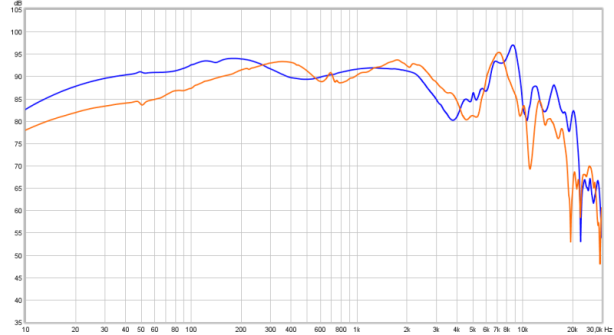 The fake version has much less lows and poorer mids. Treble also has a peak but drops of much sooner. The power rating of the fake is 25mW which is very small compared to the 2000mW of the original. The fake version sounds quite ‘mediocre’ and thin and lacks sparkle and ‘air’.
The fake version has much less lows and poorer mids. Treble also has a peak but drops of much sooner. The power rating of the fake is 25mW which is very small compared to the 2000mW of the original. The fake version sounds quite ‘mediocre’ and thin and lacks sparkle and ‘air’.
While the original version sounds balanced the fake version is mostly midrange.
Below was the first measurement that was made of the ATH-MSR7. There was a substantial tonal balance difference above 300Hz. I measured it 3 times to be sure it wasn’t positioning or something else I overlooked. It turned out to be caused by the pads on the right cup being worn.

After a L-R pad swap the difference went into the other channel.
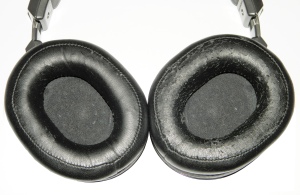 The worn pad on the right side compressed more and also seems to absorb higher frequencies a bit more.
The worn pad on the right side compressed more and also seems to absorb higher frequencies a bit more.
After this I made a set of measurements with the good pad on the right side and used these for creating plots for L and R sides.
Seal
Seal can be an issue with closed-back headphones but is usually less of a problem for open headphones. Breaking the seal (improper fit on the head) usually means a loss of (sub)bass. Below the effect of different levels of seal breach are shown .
Perfect seal, Seal broken with a thin arm (temple) pair of glasses, Seal broken with a thick arm (temple) pair of glasses, seal broken using a 6.3mm TRS plug.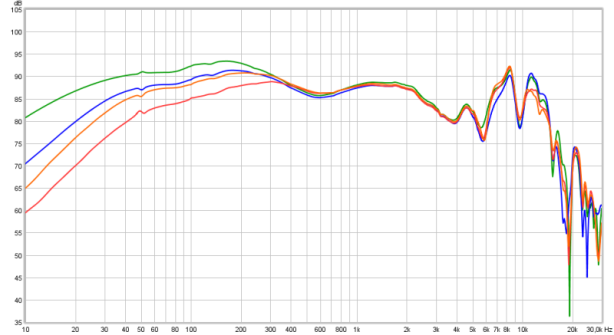 The ATH-MSR7 reacts as can be expected from a closed headphone. When using glasses the loss of subbass is not immediatly audible. One can check this by listening with and without glasses on or by pushing the cups a bit more against the head. The highish clamping force and soft pads will ensure a fairly good seal though. When a substantial seal loss is present bass levels are compromised though.
The ATH-MSR7 reacts as can be expected from a closed headphone. When using glasses the loss of subbass is not immediatly audible. One can check this by listening with and without glasses on or by pushing the cups a bit more against the head. The highish clamping force and soft pads will ensure a fairly good seal though. When a substantial seal loss is present bass levels are compromised though.
output resistance / damping-factor
As this is a dynamic headphone the frequency response might be amplifier output resistance dependent when certain higher output resistance amplifiers are used.
To test this the headphone is measured via a low impedance amplifier (0.2Ω) and a high impedance amplifier (120Ω). On a higher output resistance amplifier the output level will be 12.5dB lower. To compensate for this the amplifier is cranked up to the same level (at 1kHz) as the low impedance amplifier. This way the plots are overlay-ed and it is easy to see how the tonal balance changes. 
The good news here is that a higher output resistance only results in a lower output level. The impedance is as good as ruler flat and the tonal balance is not affected by the output resistance at all. Not even with very old receivers with 600Ω output resistances on the headphone output. (the small difference at 50Hz is indeed caused by… mains hum)
Below the distortion measurements of the ATH-MSR7 (Left channel, good pad).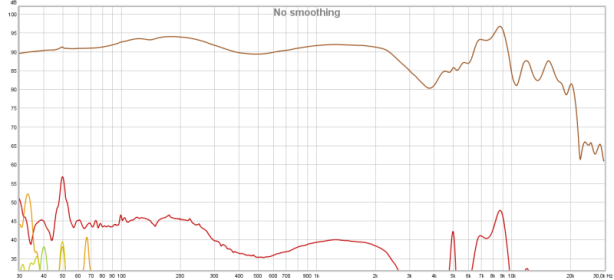 The plot above is in a dB scale, below the same measurement but in a percentage scale.
The plot above is in a dB scale, below the same measurement but in a percentage scale.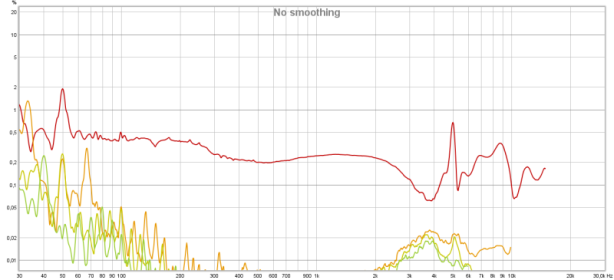 The distortion is surprisingly low for a 45mm driver at 90dB SPL. Never mind the 50Hz peak… that’s hum. Especially in the lows the distortion is very low. At 5kHz there is a very narrow band which peaks just above 0.5% and is not something to worry about.NOTE: The actual 2nd harmonic distortion above 300Hz may well be lower than 0.2%. A shortcoming (measurement limit) of my measurement rig.
The distortion is surprisingly low for a 45mm driver at 90dB SPL. Never mind the 50Hz peak… that’s hum. Especially in the lows the distortion is very low. At 5kHz there is a very narrow band which peaks just above 0.5% and is not something to worry about.NOTE: The actual 2nd harmonic distortion above 300Hz may well be lower than 0.2%. A shortcoming (measurement limit) of my measurement rig.
Time domain measurements
Below the CSD of the ATH-MSR7 (Left and Right are superimposed)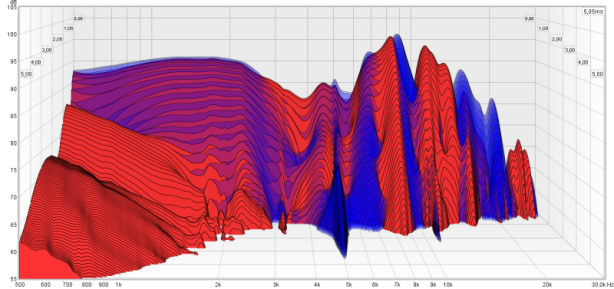 A small but short lived resonance is seen at 5kHz (also visible in the distortion plot).
A small but short lived resonance is seen at 5kHz (also visible in the distortion plot).
The ringing that is there above 6kHz is very short lived and well damped.
Another form of looking in the time domain is the spectrum plot. The amplitude is color coded and both the time scale and frequency scale differ as well.
Below the spectrum plot of the ATH-MSR7 (Left channel, good pad) 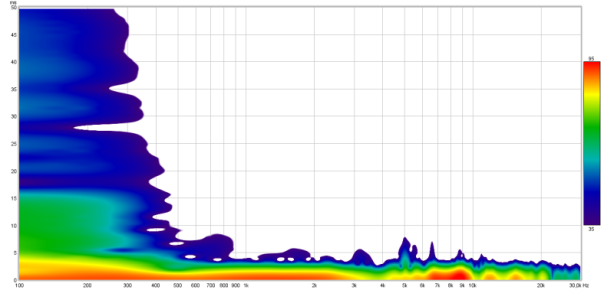
This plot looks quite good. There are no obvious, long lived resonances visible. A short one at 5kHz but otherwise this driver looks well damped.
Below the step response with a dB scale (so not similar to an oscilloscope plot which has a linear scale). The step response (Left and Right channel overlayed) 
There is some short lived ringing visible. The tonal balance is ‘clear’ (a small emphasis between 100μs and 300μs followed by the hint of ‘warmth’ (around 1ms).
Bass extension is quite good given that the horizontal port doesn’t drop that much.
There is a left-right difference in tonal balance (measured both channels with good pads) which is also seen in the Frequency response plot above 1kHz.
Square-wave and impulse response
Below the 40Hz and 440Hz square-wave response as well as a 100μs DC impulse.
 There is decent bass extension for both pads (40Hz). The measured level with the s is closer to the applied (target) level, The peak at the left side of the square-wave is caused by the slight midbass bump.
There is decent bass extension for both pads (40Hz). The measured level with the s is closer to the applied (target) level, The peak at the left side of the square-wave is caused by the slight midbass bump.
For the 440Hz signal the rising part at the end of the square-wave is caused by the midbass emphasis.
The impulse shows excellent impulse response. The reaction after the impulse is very small and quite well damped. There is a very slight overshoot because of the treble peak.
Getting rid of the treble peak
The best way to get rid of the treble peak is to use EQ or a passive in-line filter. This filter lowers the treble peak to ‘normal’ levels and leaves the rest of the sound as it is.
Below the response of the ATH-MSR7 with and without the filter.
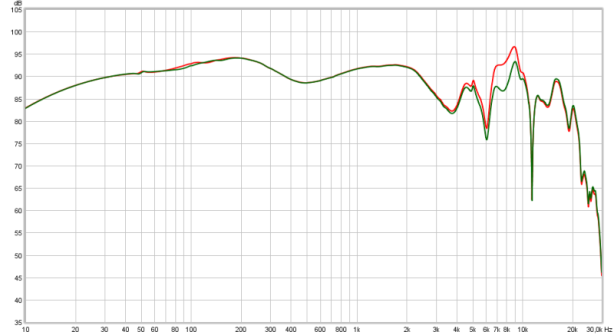
The 5dB reduction is quite audible and removes the sharpness. The clarity and ‘attack’ remains, the treble is just not ‘sharp’ any more.
Below the schematic for this filter.
When you can not make this filter yourself or don’t know someone that can do this for you a built filter can be ordered.
summary
The audio-technica ATH-MSR7 is an excellent performing (measurement and sound) headphone that is well made and won’t break the bank. Well suited for desktop and studio usage.
Comfort also is good but the clamping force is on the high side. The sound is quite neutral but definitely not boring. It is lively, has a tight but not overblown bass and good forward and clear mids but is a bit bright and sharp in the treble part.
When you aren’t bothered by the treble peak this is a very good sounding headphone.
Overall a well priced and nicely made closed headphone with decent attenuation for outside noises. Plays well and loud enough from portable devices/phones etc.
A headphone worth owning for those that like a realistic and lively sound and are not looking for warm , bassy, ultra smooth / mushy /subdued relaxing sound.
